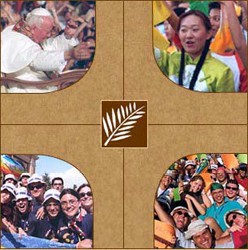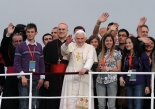Many people say that WYD is Pope John Paul II’s best invention. He used to say that it was the young people themselves who invented it. Let us take a look at how this adventure started. There was a Holy Year of the Redemption in 1983-1984, 1950 years after the Passion of Jesus. One of the activities that John aul II decided to hold was a gathering of young people on Palm Sunday. The organising committee expected about 60,000 participants. 250,000 came.
In 1985 the UN proclaimed an international year of youth. The Pope felt that the Church’s concern for the younger generations should be made known, and so he issued another invitation to young people to come to Rome for Palm Sunday. Again the response was huge. 300,000 young people gathered in churches around the city for times of prayer and catechesis, and then they met together in Saint Peter’s Square to take part in the ceremonies with the Holy Father.
After these two gatherings, many people were left wondering why there had been such a huge response and what young people were seeking. John Paul II had expected it. He knew that young people felt the need to meet together to share their experiences, to listen to words of faith, to look to the future together, and to renew and confirm their commitment. At the end of 1985 he announced the institution of World Youth Day and that it was to be celebrated every year in the dioceses. The Pope also named a day for the celebration: Palm Sunday. Why? John Paul II tells young people: “The response is given by all of you who have been coming to Rome on pilgrimage for many years precisely to celebrate this day [...]. Does this not mean perhaps that you yourselves are searching for Christ at the heart of his mystery? You are seeking it in the fullness of the truth which is Christ himself in the history of humankind” (Homily, 27 March 1988, Palm Sunday Mass, 3rd World Youth Day).
The diocesan celebrations were soon joined by international gatherings. At first these took place every two years. The first WYD was held in the dioceses in 1986, and then the first international gathering was held in 1987 in inBuenos Aires, Argentina, a strong message to a country that was emerging from dictatorship. The 4th WYD in1989 was held in Santiago de Compostela in Spain. This is a well-known centre of faith in Europe that attracts huge numbers of young pilgrims from all over the world. The 6th WYD in Czestochowa in Poland in 1991 was the first great meeting of young people from Eastern and Western Europe after the fall of the Berlin Wall. The 8th WYD in 1993 left the old continent and went to Denver in the United States.
Here the young people were invited to proclaim Christ without fear, even in the heart of a modern metropolis. InManila in the Philippines in 1995, in spite of the scarcity of available financial resources, the 10th WYD turned out to be the largest gathering ever known. In 1997, the 12th WYD took place in Paris in France and was a new “French revolution”. Masses of young people filled the streets and squares singing about their faith, and showing a spiritual thirst and a missionary desire that was really amazing. In the Jubilee Year of 2000, the 15th WYD was held in Rome. John Paul II, in spite of his advancing illness, joyfully shared in this amazing time of grace with nearly two million young people. He asked them to be “sentinels of daybreak”. In 2002, the 17th WYD was held in Toronto in Canada. The young people, “people of the beatitudes”, came to proclaim Christ in a modern, multicultural country. In 2005, shortly after the death of John Paul II, Benedict XVI presided over the 20th WYD in Cologne in Germany. It was centred on Eucharistic adoration, recalling the adoration of the Magi whose relics are kept in the city cathedral. In2008, the 23rd WYD was held in Sydney in Australia, the “Land of the Holy Spirit”, a continent that was new and distant for many, but WYD was finally brought close to many youth in the southern hemisphere. Now WYD is returning to Spain when it comes to Madrid to help young Europeans to rediscover the values that founded Europe. It will also showcase the beauty of a country that is rich in historical, artistic and cultural testimonies of a long tradition steeped in faith.
Father Eric Jacquinet







